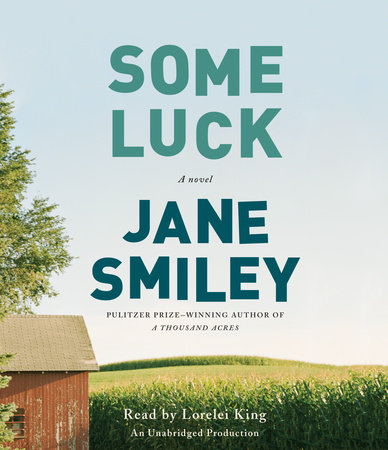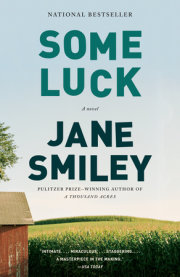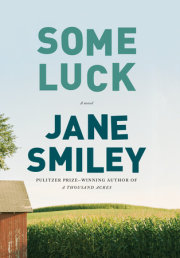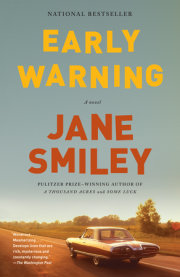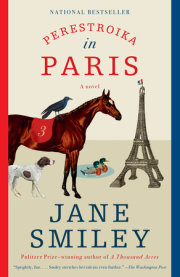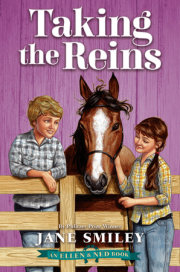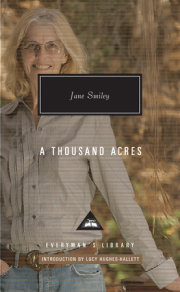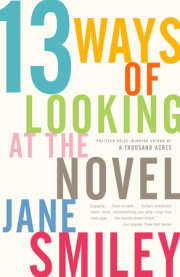“This sweeping, carefully plotted novel traces the history, from 1920 to the Cold War era, of a single Iowa farming family. Each chapter focuses on one year, setting the minor catastrophes and victories of the family’s life against a backdrop of historical change, particularly the Great Depression. As the children branch out from their tiny town, so, too, does the story, eventually encompassing several generations, cities, and cultural movements. Smiley, like one of her characters contemplating the guests at the Thanksgiving table, begins with an empty house and fills it ‘with twenty-three different worlds, each one of them rich and mysterious.’” —The New Yorker
“What’s unusual about Some Luck is how closely it’s meant to mimic real life, and yet how important Smiley’s gifts as a novelist are to achieving that effect. The way the story unfolds makes it feel not so much like reading a novel as catching up with relatives every couple of months, finding out who’s been up to what and comparing stories. Characters reminisce about scenes from earlier in the book that start to feel like our memories, too. Smiley’s ability to sketch a scene, to bring to life the quiet incidents as well as the big ones—the moment when something finally makes sense, or a decision is reached, or someone lets slip something they shouldn’t—are what transform the family stories into literature . . . Some Luck draws the reader in with easy charm.” —Christine Pivovar, Kansas City Star
“A magnificent achievement . . . Pulitzer Prize-winning Smiley has embarked on an audacious project: the first volume of an epic family chronicle that spans the past century. She pulls it off handily; her touch is light and assured. With each passing year, the Langdons respond to the events that shaped America itself . . . While written with humor and affection, Some Luck is a constant reminder of how fleeting life really is. Babies arrive with little warning. Children die in freak accidents. Families care for their aging and failing elders. Walter and Rosanna both worry constantly—about their farm and their family. In the end, it all comes down to luck.” —Amy Goodfellow Wagner, Examiner.com
“The fertile first installment of Smiley’s century-spanning trilogy of fatalism, farm life and family—a big story of a big family in a big country. [But] the focus is up-close and intimate: Smiley cultivates her characters in scenes that are sometimes lightly comical, touchingly sad, sweet, or slightly strange, and they are always perfectly, beautifully true to life. She gives every Langdon careful consideration—endowing each of them with discrete likes, dislikes, private thoughts, and secret hopes and fears—but it is Frank, the baby born on New Year’s Day, 1920, who breaks the mold . . . The reader longs for the Golden Age of the early chapters and the way of life we know will not survive, even as we eagerly await the sequel. And all we can do is wait, patiently.” —Sandra Levis, The Pittsburgh Post-Gazette
“Engaging. . . . Smiley is a self-assured writer, a skillful stylist who launches her story from a baby’s-eye view. She plumbs the drama in ordinary life, hitting all our nostalgia buttons on the way, from the one-room schoolhouse and horse-drawn plow to the TV set. As the landscape changes, from a vista of corn fields and self-sufficiency to green lawns and consumerism, Smiley is a master of the telling detail . . . Populated by sympathetic characters who take what life brings, [this] is a look back at what feels like simpler times. Family is Smiley’s turf, and she plays it well.” —Ellen Emry Heltzel, The Seattle Times
“The wonderful first installment of Smiley’s The Last Hundred Years Trilogy, which tells the story of an Iowa farm family from 1920 to 2019. As far as I’m concerned, the next two cannot follow soon enough . . . Over the years, the Langdons will have six children, each with their own interesting life, messy desires and flaws that will compel them out into the world, some far from the farm that the family both loathes and loves. There are deaths, blizzards, droughts, and accidents, as well as births, celebrations and beautifully narrated family meals, like a particular Thanksgiving near the end of the novel . . . Extremely satisfying.” —Natalie Serber, The Oregonian
“Brilliant . . . Smiley is one of America’s most accomplished and wide-ranging novelists, [and] Some Luck finds her in her most tender mode. I happened to be reading Farmer Boy by Laura Ingalls Wilder to my daughter at the same time I was enjoying Some Luck; and Some Luck holds up well against Wilder’s classic in its lovely, precise portrayal of the day-to-day rhythms of agriculture and what it’s like to be a child growing up inside the close, hardworking, economic unit of the family farm. But it also extends beyond Wilder’s scope, as you’d expect in a novel for adults. There are cow milking and field plowing in Some Luck, but there are also duplicity, romance and despair . . . Smiley moves through several characters’ perspectives, writing in an old-fashioned, Tolstoyan omniscience that even explores the mind of [a] baby . . . As the Langdons’ five children grow up and scatter from coast to coast, Some Luck demonstrates how events on an isolated, unsophisticated farm in the middle of the country represent and influence the larger story of America.” —Jenny Shank, Dallas Morning News
“Satisfying . . . captivating . . . the reading experience is rewarding.” —Rebecca Kelley, Bustle
“Unforgettable, graceful . . . The characters in Smiley’s latest novel take what life throws at them—drought, freezes, economic catastrophe, death, war, progress—and carry on. Despite its epic scope, which embraces political and social changes, Some Luck is also intimate, and deeply observant. Smiley uses small moments and events to build a bigger, multifaceted picture of a country during decades of great change. What seems simple at first grows profound in her hands—and her skillful prose. With plain materials she builds rich portraits of her Langdons: Walter, Rosanna, [and] their five children are rendered in vivid, indelible strokes . . . A simple, remarkable scene—nothing fancy, just a loud, large family gathered for a Thanksgiving meal—leaves you with that warm feeling you get when you flip through old family photo albums, marveling at the past. In Some Luck, Smiley brings that past to life. You don’t have to have been raised on an Iowa farm to think: That sounds like my grandmother, my aunt, my father, my brother. That sounds like us.” —Connie Ogle, Miami Herald
“A ravishing and defiantly old-fashioned novel set on the same Iowa soil Smiley tilled in her Pulitzer Prize-winning A Thousand Acres . . . . Reminiscent of the work of Willa Cather and Alice Munro, Some Luck chronicles one family’s triumphs and travails as they work to wrest a living from their farm. Opening in 1920, [it] tracks the fates of Walter and Rosanna Langdon and their children over three decades. Their union endures, roiled by doubt at times, yet rooted in a bone-deep connection. Some Luck ingeniously spirals outward from the farm and back again, capturing the arc of personal and historical change in forthright prose that unexpectedly takes flight.” —Hamilton Cain, O, The Oprah Magazine
“Fans of old-fashioned family sagas featuring historical sweep are in (ahem) some luck. Like A Thousand Acres, Some Luck conveys a deep understanding of both the endless work and worries of agrarian life and the foremost question among children raised on the land—whether to stay or go. Some Luck’s narrative shifts focus among various members of the Langdon family, including its youngest. What’s it all about, having a family? Rosanna’s reflections during a Thanksgiving gathering in 1948—a perfectly written scene [and] the climax and beating heart of Some Luck—captures the payoff, the sudden moments of grace that can astonish and melt even the most exhausted, unsentimental readers. An intimate, telling portrait of the changing landscape of hearth and home in twentieth-century America . . . The writing positively soars.” —Heller McAlpin, The B&N Review
“Sweeping, bold, and completely engrossing . . . arguably Smiley’s finest work—she delivers with Some Luck. It moves swiftly, keeping the reader turning the pages. Smiley’s reach is wide and assured. Few authors are able to write equally well about war strategy, Communism, cover crops, and postpartum depression. Smiley can, and does, such that when Some Luck closes it feels sudden, despite the novel’s length. The reader isn’t ready to leave the Langdons behind. Take consolation in knowing there is more to come: Some Luck is the first installment of a promised trilogy. In this case, the luck is all ours.” —Diane Leach, PopMatters
“Sweeping . . . Smiley’s most commanding novel yet. She is a master storyteller—that rare ‘three-fer’: meticulous historian, intelligent humorist and seasoned literary novelist . . . But what makes a Smiley novel identifiably and deliciously hers alone is a unique brand of impassioned critical patriotism. She makes us see, in the kindest, gentlest way, that we’re a lot more wonderful, and a lot more screwed up—as a nation, as a people, as families, as individuals—than we think we are. Some Luck contextualizes three decades of American history by zooming in on one multi-generational farm family. Births and deaths, triumphs and tragedies are rendered in a [way] that mirrors the Midwestern landscape, language and temperament. The low, quiet hum of the narrative voice provides a contrast for the family’s crises, each of which serves to connect the reader to her characters . . . The rolling out of all those life events, big and small, have a cumulative effect, [and] by the end, the attachment to the Langdons is enough to make the reader count down the days to Book Two.” —Meredith Maran, Los Angeles Times
“Midwestern farm country has proved fertile soil for fiction writers, and no one has cultivated it to such fine effect as Smiley. This new novel, the first in a Balzacian project—the saga of the American family sprung from immigrant stock rooted in farmland—follows a family through major events of the first half of the 20th century. Smiley’s range is, as ever, remarkable: she inhabits the heroic firstborn, the diffident little brother, the angelic girl, the bookish boy, the [child who is an] afterthought, always managing to convey the specific nature of each character’s experience, even as her narrative balances birth order as fate against character as destiny. The cumulative experiences of these people, all depicted with such convincing care and detail, convey a sense of the relations that create a world.” —Ellen Akins, Minneapolis Star Tribune
“Delightfully engaging, a novel full of pleasures both large and small. History makes its way into the story realistically and unobtrusively—the history is personal, told in stories passed down through generations. The chronological approach allows the novel room to breathe . . . Smiley clearly enjoys her characters without being besotted by them. Her writing has an edge of gentle humor about a place that has four seasons: ‘mud, heat, harvest exhaustion, and snow.’” —Margaret Quamme, The Columbus Dispatch
“Engrossing . . . While Some Luck evokes the Iowa landscape Smiley knows well, the novel is as much about the passage of time as the people inhabiting it. As the years pass and crops grow, so does the Langdon family. Parents Walter and Rosanna have their first child, Frank. Smart, charismatic and restless, he’s followed by sensitive, reliable Joe; sweet-natured Lillian; bookish Henry; and baby Claire. From birth, each is an indelible character . . . ‘All ordinary people are extraordinary,’ she says. ‘I don’t actually believe in the concept of ordinary people. I think individuals are always interesting . . . They have unique lives, and things happen to them. They all have adventures.’” —Georgia Rowe, San Jose Mercury News
“Fascinating—an impressive accounting of family life . . . Some Luck would qualify as Smiley’s magnum opus if this, her 14th novel, were a single work and not the first in her trilogy. [As] the story, told from the multiple viewpoints of the Langdon family, moves through history, Smiley portrays her characters with such clarity that we care about their fate . . . The book’s message [is] that farm life is a harrowing enterprise, needful of great reserves of fortitude. Frank will grow up handsome, brilliant and heartless—the mesmerizing center of the book . . . No one captures the rhythms of ordinary life like Smiley does: babies, sewing, cooking . . . In 1992 Smiley’s A Thousand Acres won the Pulitzer for fiction and looked to stand as her epic achievement, retelling King Lear in Iowa. Now, with Some Luck and a return to the heartland, the remarkable Smiley just got a little more remarkable.” —Barbara Liss, Houston Chronicle
“A masterpiece in the making . . . intimate, miraculous—the auspicious beginning of an American saga every bit as ambitious as Updike’s magnum opus, anchored in the satisfactions and challenges of life on a farm, but expand[ing] to various American cities and beyond . . . Frank is one of the most fascinating and complex characters in recent fiction. The way Smiley gets deep inside [all] the children’s heads is a staggering literary feat in which we see human character being assembled in something that feels like real time. An abundant harvest.” —Kevin Nance, USA Today
“Engaging, bold . . . Smiley delivers a straightforward, old-fashioned tale of rural family life in changing times, depicting isolated farm life with precision . . . It is especially satisfying to hear a powerful writer narrate men’s and women’s lives lovingly and with equal attention. Subtle, wry and moving.” —Valerie Sayers, The Washington Post
“Convincing . . . A young couple, Walter and Rosanna Langdon, are just setting out on their own [in] 1920. Eventually they will have five children; Smiley gives each of them a turn in the spotlight, filling in the details of their lives and drawing the reader into a story meant to last a long time . . . Smiley has been compared to some of the great writers of the 19th century, [and] in that tradition, she gives her trilogy the sweep of history. But what interests her most is the way historic events play out in the lives of one family whose roots are deeply embedded in the middle of America.” —Lynn Neary, NPR Weekend Sunday Edition
“Smiley is prolific [and] seemingly writes the way her idol Dickens did—as easily as if it were breathing . . . She made up her mind at an early age that she was going to master not just one genre, but all of them. Her new book is the first volume of a trilogy—one of the few forms left for her to tackle . . . Some Luck starts in 1920 and follows the fortunes of a Midwestern farming family; each chapter covers a single year. What most surprised her, she said, was the way that, more than in her other books, the characters took on lives of their own. ‘I got the feeling that I got on a train and sat down, and all these people were talking. I was eavesdropping, and the train was just heading into the future.’” —Charles McGrath, The New York Times
“Audaciously delicious . . . Every character here steals our heart. Smiley has turned her considerable talents to the story of an Iowa farm and the people who inhabit it. The suspense is found in the impeccably drawn scenes and in the myriad ways in which Smiley narrows and opens her camera’s lens. Her language has the intimacy of a first-person telling; her stance is in-the-moment. Always at the narrative hearth stand Walter and Rosanna and that Iowa farm, a character in its own right, a landscape remembered by those who flee to Chicago, Italy, San Francisco, Washington D.C. and New York . . . We read these lives, and we find our own.” —Beth Kephart, Chicago Tribune
“Sumptuous . . . A meditation on the things we encounter in our lives that shape our personal histories. Smiley impresses the reader by shifting perspectives that include those of the Langdon children as infants and toddlers learning how to grip, walk—and manipulate their parents and siblings. Readers will find much enjoyment in Smiley’s sharp prose and finely observed details. She’s in no hurry to get us anywhere, allowing readers to luxuriate in this study of character, place and time. By the time I got to the end of this big, human book I wondered where the time had gone.” —Christi Clancy, Milwaukee Journal Sentinel
“Quietly suspenseful, subtle, and captivating . . . We see a changing world through the eyes of a hard-working family trying to make ends meet on their farm in the Iowa heartland. Some Luck is set against a backdrop of sweeping social, political, and economic change—the Great Depression, the rise of Communism, World War Two, and innovations like electricity and automobiles. As the landscape evolves, the Langdons’ world expands beyond the corn fields to the big city, a university campus, and the battlefield . . . Their family life is filled with conflict, rivalries, and shifting alliances—the reader forms a close bond with them . . . Smiley’s deft prose is succinct and clear; she covers the span of a season in a few sentences, then focuses on an ordinary event that turns out to have enormous consequences. The mundane becomes profound, and the effect is smooth and seamless.” —Eleanora Buckbee, Everyday eBook
“No writer has ever captured the satisfactions and frustrations of the American farmer with more insight, humor, accuracy and grace than Smiley. In the first novel of her forthcoming trilogy, she serves up 33 years (1920-53) of American history, viewed through the particular lens of an Iowa farm. The Depression, the Dust Bowl, WWII and the early Cold War provide a compelling backdrop to the lives of Walter and Rosanna Langdon and their six children, all drawn with Smiley’s signature specificity and clear-eyed compassion. The storytelling is shared among the characters, [with] each chapter representing one year of drought or plenty—an almanac to honor these harsh and beautiful lives.” —Pam Houston, More
“Starting from a farm in Iowa, the Langdon family knows growth, diaspora, heartbreak, and passion over three decades. It’s breathtaking to realize that this novel is the first of a trilogy!” —Philadelphia Inquirer
“From Pulitzer winner Smiley, a multi-generational saga about an Iowa farming family’s shifting fortunes.” —Kim Hubbard, People, One of the “Best Books of the Fall”
“Marvelous, a tour de force . . . Some Luck opens in 1920 with Walter Langdon on the eve of his 25th birthday, thinking about the vicissitudes of farming; his strict father; his wife; and his five-month-old son—the first of five children who grow into memorable individuals over the course of the novel. With her vivid, tactile depiction of rural Iowa farm life, Smiley has imaginatively recaptured the dangers and rewards—the play of good luck and bad luck—in a lost way of life . . . Some Luck moves swiftly and assuredly through 33 years of the Langford clan’s experiences, [becoming] an exploration of 20th-century American culture and politics. Smiley says the novel’s velocity arises from the year-by-year approach she deploys throughout the trilogy. She says she began with the concept of the trilogy but ended up being swept away by the trajectories of her characters. She writes about farm life, family life and, suggestively, near the end, national political life. There are farming scenes, sex scenes, combat scenes and table-talk scenes . . . Wherever Smiley goes in Some Luck, most readers will willingly follow. Then wait, with bated breath, for her next steps.” —Alden Mudge, BookPage
“Kicking off a new trilogy that follows the Langdon family for 100 years, this novel starts with their humble beginnings on an Iowa farm, and takes them from the Depression to the Red Scare. As times change, so do relationships, hearts and minds.” —Woman’s Day
“Epic, striking . . . The reader becomes intimately involved with the characters amid the minutiae of family life, sharing Rosanna’s anxieties over the children and Walter’s worries about his crop prices, understanding Frank’s desire to leave and Joey’s desire to stay. The cumulative effect is a story so fully immersive and absorbing that I finished the book with a sense of loss. Masterly.” —Alice O’Keeffe, The Bookseller (UK)
“The expansive American epic is Smiley’s métier, and she’s in top form with this multigenerational story of an Iowa farming family—sturdy sons, passionate daughters, a tough but tender existence—across the first half of the 20th century.” —Time
“Pulitzer Prize-winning Smiley moves from the 1920s to the 1950s as she unfolds the life of Iowa farmers Rosanna and Walter Langdon and their five children. As the children grow up and sometimes move away, we get a wide-angle view of mid-century America. Told in beautiful, you-are-there language, the narrative lets ordinary events accumulate to give us a significant feel of life at the time, with the importance and dangers of farming particularly well portrayed. In the end, though, this is the story of parents and children, of hope and disappointment . . . Highly recommended; a lush and grounded reading experience.” —Barbara Hoffert, Library Journal (starred review)
“Tremendous . . . Smiley is a seductive writer in perfect command of every element of language. She was awarded the Pulitzer Prize for A Thousand Acres, a novel about a farming family in Iowa, and she returns to that fertile ground to tell the stories of the Langdons, a clan deeply in accord with the land . . . As barbed in her wit as ever, Smiley is also munificently tender. The Langdons endure the Depression, Walter agonizes over giving up his horses for a tractor, and Joe tries the new synthetic fertilizers. Then, as Frank serves in WWII and, covertly, the Cold War, the novel’s velocity, intensity, and wonder redouble. This [is a] saga of the vicissitudes of luck, and our futile efforts to control it. Smiley’s grand, assured, quietly heroic, and affecting novel is a supremely nuanced portrait of a family spanning three pivotal American decades. It will be on the top of countless to-read lists.” —Donna Seaman, Booklist (starred review)
“Exciting. . . In the first volume of a planned trilogy, Smiley returns to the Iowa of her Pulitzer Prize winning A Thousand Acres, but in a different vein. The Langdons [are] a loving family whose members, like most people, are exceptional only in their human particularity; the story covers the 1920s through the early ‘50s, years during which the family farm survives the Depression and drought, and the five children grow up and have to decide whether to stay or leave. Smiley is particularly good at depicting the world from the viewpoint of young children—all five are distinct individuals from their earliest days. The standout is the oldest son, Frank, born with an eye for opportunity. But as Smiley shifts her attention from one character to another, they all come to feel like real and relatable people. Smiley conjures a world—time, place, people—and an engaging story that makes readers eager to know what happens next. Smiley plans to extend the tale of the Langdon family well into the 21st century; she’s off to a very strong start.” —Publishers Weekly (starred review)
“Smiley follows an Iowa farm family through the thick of the 20th century, [as] the Langdons raise five children to varied destinies; [there’s a] sense that we’ve simply dropped in on a continuing saga. Smiley juggles characters and events with her customary aplomb and storytelling craft . . . Underpinning the unfolding of three decades is farm folks’ knowledge that disaster is always one bad crop away, and luck is never to be relied on; it wouldn’t be a Smiley novel without at least one cruel twist of fate. Smiley is the least sentimental of writers, but when Rosanna and Walter Langdon look at the 23 people gathered at Thanksgiving in 1948 and ‘agreed in an instant: something had created itself from nothing,’ it’s a moment of honest sentiment, honestly earned. An expansive tale showing this generally flinty author in a mellow mood: surprising, but engaging.” —Kirkus (starred review)

